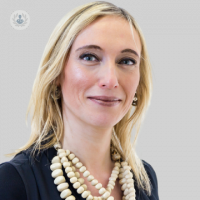Strabismus (squints) in children
Written by:In children, a squint, or crossed eye (strabismus), is often a sign that their eye is attempting to overcome a vision problem. Children are susceptible to developing squints as their vision system develops throughout childhood. Leading London-based consultant ophthalmologist Miss Joanne Hancox elaborates on the causes of childhood squints, and when a specialist should be visited.

What causes a child to squint?
There are numerous reasons why a child can develop a squint. Some children have congenital problems meaning they’re born with a squint, or it develops within the first 6 months of life, known as early-onset or infantile esotropia. Others develop squints later on in childhood. Our eyes stay straight because the brain has a mechanism to control them and keep them working together. As a general principle, this mechanism often doesn’t work as well in children who have squints.
A child’s squint may also be related to the way their eyes focus. Children that have what is considered a higher-than-normal refractive error, such as hypermetropia (long-sightedness) squint as a result of their effort to focus their eyes without glasses.
Can a child grow out of a squint?
There are certain squints that some children will grow out of. It is very common for young children in the first few months of life to have an intermittent squint, that can be occasionally seen by the parents. This is often part and parcel of visual system development. When you are born, your eyesight is poor, and you cannot see in colour for the first three months of your life. Additionally, the brain has to learn how to use your two eyes together. Sometimes as part of this process, an intermittent squint can be seen, which the child grows out of very quickly, usually in the first few months. In the case of permanently present squints, it is much more unlikely that a child will grow out of it, and it should always necessitate an assessment by an ophthalmologist.
Squints that a child develops at a later stage of childhood, such as an intermittent exotropia which is the intermittent divergence of the eye causing it to drift out, can also be grown out of overtime.
What are the different types of squint?
The commonest type of squint in a child is what we call an esotropia, where an eye deviates inward. Another type of squint seen frequently in children is exotropia, where the eye drifts outward. Both of these may be intermittent or permanent, depending on the individual case.
There are other types that cause a vertical deviation, an imbalance of the eyes up and down, such as dissociated vertical deviation and inferior oblique overaction. Vertical deviations can commonly be associated with early-onset esotropia.
A number of more unusual or developmental type squints can occur also. Duane syndrome may arise as a result of poor development of one of the nerves that supply one of the muscles that move the eye. Brown syndrome is when the eye finds it difficult to elevate when it is in-turned and is caused usually by a blockage where the muscle that moves the eye in that position gets stuck over the pully that it moves over.
When should you visit a doctor?
If there is any concern at all, that a child has a squint, they should be referred to a specialist immediately. The assessment of eye squints is a complex process and it is not just the doctor that is important. Assessment is carried out by a team consisting of orthoptists, optometrists, and doctors. I suggest that any incident of a suspected squint in a child, particularly in younger children, is referred to a hospital for specialist assessment.
In addition, some children look like they have a squint, however, when assessed they are diagnosed with what is called a pseudo-squint. Although it may appear like a squint, when the measurements are taken during an assessment, their eyes are actually straight. It is far better that children suspected of having a squint are assessed to ensure they don’t have one, rather than for these children not to be.
If you are worried about your child's vision and would like to book a consultation with Miss Joanne Hancox, you can do so by visiting her Top Doctors profile today.


